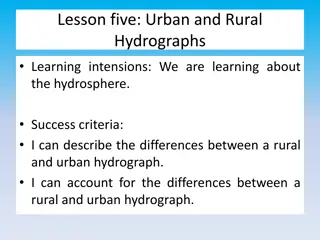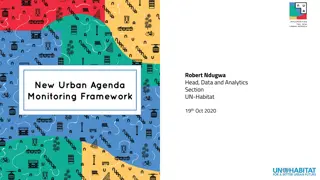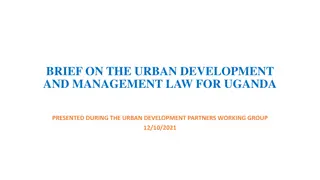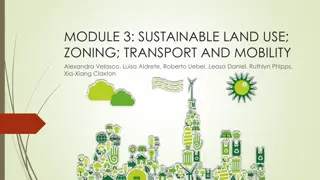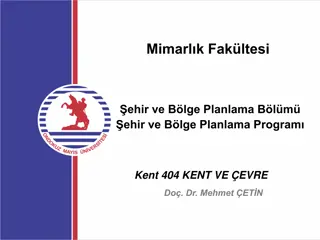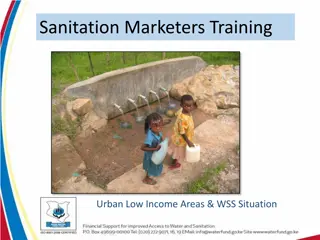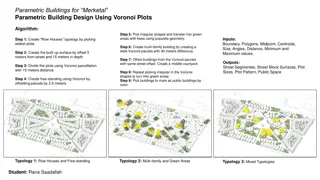Exploring Environmental Impact of Green Areas in Urban Spaces
Engage in a city walk to measure temperature and humidity in green and urban areas. Understand the relationship between these variables, the significance of green spaces in urban environments, and the effects of urbanization on microclimates and quality of life.
Download Presentation

Please find below an Image/Link to download the presentation.
The content on the website is provided AS IS for your information and personal use only. It may not be sold, licensed, or shared on other websites without obtaining consent from the author. Download presentation by click this link. If you encounter any issues during the download, it is possible that the publisher has removed the file from their server.
E N D
Presentation Transcript
A walk through the city Measuring environmental temperature and humidity in green areas and around urban areas
A walk through the city Measuring environmental temperature and humidity in green areas and around urban areas Objective The purpose of this activity is to study the relationship between temperature and humidity in several locations inside and outside school, creating a hypothesis and proceeding to test it using the SensorLab external temperature, relative humidity and GPS sensors. The goal is to obtain the values of these variables in urban spaces and in green areas.
A walk through the city Measuring environmental temperature and humidity in green areas and around urban areas Introduction and theory The aim of the introduction is to focus students on the lesson subject by refreshing acquired knowledge and asking questions which encourage research development. Key concepts from the theoretical framework, applied by the students during the lesson, are taught. Introduction Trees and green areas generally have a positive influence on the sun s radiation, temperature, winds, environmental humidity, evapotranspiration and precipitations. This is why people usually agree on the importance of taking care of such places, even in city centers where we mostly find buildings and industrial parks. When do you use green areas? Tell us several outdoor activities that you like to take part in. Have you ever entered a park after walking for a long time in the sun? Describe your experience.
A walk through the city Measuring environmental temperature and humidity in green areas and around urban areas Introduction and theory Carry out the experiment activity with your class so that at the end you ll be able to answer the following question: How do green areas affect environmental temperature and humidity?
A walk through the city Measuring environmental temperature and humidity in green areas and around urban areas Introduction and theory Theoretical The population of cities grows around two to three times faster than the population of country areas. This means, an increasing number of buildings, industries and roads, while the number of trees and green places in the city can be observed to decrease. This makes for microclimate change, and often affects the quality of life for the city s inhabitants. There are several possibilities for green areas in a city: Gardens, waterfronts, linear corridors, community gardens, wild areas and traditional parks. In particular, parks significantly change their environment - improving the air quality ventilation, and filtrating large amounts of rain water. Depending of the size of the park, it may also provide a habitat for a variety of fish, birds, insects and other animals, along with protecting the diversity of the flora. In addition, green areas are great places to practice sport and rest, or to just go and have fun with your friends and family.
A walk through the city Measuring environmental temperature and humidity in green areas and around urban areas Introduction and theory We can find a great variety of plants and flowers; crawling herbs, tall and short plants, vines, shrubs and trees. We may find varieties of evergreen or deciduous plants, with branches forming foliage. They can be endemic (local wild species) or introduced from other countries. One of the most important plant processes is water transpiration, which contributes to maintaining the ground moisture. This way, plants most importantly trees decrease air temperature.
A walk through the city Measuring environmental temperature and humidity in green areas and around urban areas Introduction and theory Now students are encouraged to raise a hypothesis which must be tested with an experiment. In an open space, how would you expect temperature and humidity levels to change as you approach a wide green area? Why do you think this happens?
A walk through the city Measuring environmental temperature and humidity in green areas and around urban areas Activity description Students will measure and study the temperature and humidity variations in different environments (open and closed spaces) as they approach green areas, starting from their classroom. They will recognize quantitative qualities that allow them to explain the positive effect of city vegetation.
A walk through the city Measuring environmental temperature and humidity in green areas and around urban areas Resources and materials SensorLab USB communication cable Temperature probe
A walk through the city Measuring environmental temperature and humidity in green areas and around urban areas Using the SensorLab a. Using the SensorLab To collect measurements with the SensorLab relative humidity, external temperature and GPS sensors, the SensorLab must be configured according to the following steps: Turn on the SensorLab by pressing Press and select CONFIGURATION by pressing Using go to the GPS Configuration Menu, pressing to enter and selecting the Activate GPS option by pressing Press two times to go back to the menu. Go to SETUP using the button and select it by pressing Now select the SET SENSORS option by pressing
A walk through the city Measuring environmental temperature and humidity in green areas and around urban areas Using the SensorLab Select only the relative humidity, external temperature and GPS sensors and press three times. Press to start measuring. Once you have finished measuring stop the SensorLab by pressing (you will see the instruction Press SCROLL key to STOP ) and press
A walk through the city Measuring environmental temperature and humidity in green areas and around urban areas Experiment The following steps explain how to perform the experiment: Take the SensorLab and connect the external temperature probe. Start measuring from the classroom door, as you approach a nearby green area. After registering the data in the green area, approach an asphalted area. Register your observations and the exact location in your notebook. Once you have finished measuring turn the SensorLab off.
A walk through the city Measuring environmental temperature and humidity in green areas and around urban areas Results and analysis The following steps explain how to analyze the experiment results: Connect the SensorLab to the computer using the USB communication cable or via the Bluetooth wireless communication channel. In the top menu click the button and select the button. Select the last experiment on the list. Observe the graph displayed on the screen. Press the button and write notes on the graph specifying your observations according to the moment you registered the data. Click the button and select points on the graph. Pick one representative point for each location.
A walk through the city Measuring environmental temperature and humidity in green areas and around urban areas Results and analysis Fit the graph range according to your measurements, setting the y axis scale. Right click the y axis and set the minimum and maximum value according to your measurements. Round your minimum value down and your maximum value up, and enter these numbers into minimum and maximum . To see the map, click on the button which is in the top-right corner of the GlobiLab screen and then click on the button. In the top-right corner of the map, you ll see the words map and satellite . If you click on map, you ll see only the name of the streets. If you click on satellite, you ll see only the satellite image. If you click on satellite/label, you ll see the satellite image with the name of the streets.
A walk through the city Measuring environmental temperature and humidity in green areas and around urban areas Results and analysis If you want to see the exact value of each point, put the mouse s arrow on the point of the map and a label with the values will appear. In the top-left corner of the map, you ll see the zoom and the cardinal points. On the right side of the map, you ll see the scale. You can adjust the values (minimum and maximum) with the button and change them by clicking on the y axis of the map and selecting set range . To change the variables of the graph, right click on the y axis and select the variable that you want to see. To move the map, click on it and move the mouse s arrow.
A walk through the city Measuring environmental temperature and humidity in green areas and around urban areas Results and analysis Did you find differences between what you expected and your actual results? Explain. Did the humidity values at the different locations vary? Explain the differences. Which place presented the maximum humidity value? Describe it. Was the temperature recorded constant or variable? Explain.
A walk through the city Measuring environmental temperature and humidity in green areas and around urban areas Results and analysis The graph below should be similar to the one the students came up with.
A walk through the city Measuring environmental temperature and humidity in green areas and around urban areas Results and analysis Temperature versus time
A walk through the city Measuring environmental temperature and humidity in green areas and around urban areas Results and analysis Humidity versus time
A walk through the city Measuring environmental temperature and humidity in green areas and around urban areas Conclusions Following are some questions and answers which should be developed by the students in order to elaborate on their conclusions. According to your results, how do green areas affect humidity? Explain. Students should understand the conservation of humidity due to foliage. The leaf surface maintains a certain humidity level, intercepting the moist air coming from the evaporation of water from the ground. It also provides a condensation surface and transpires water as part of the life process of the tree. What kind of green area is most effective in maintaining humidity? The results should show that wider green areas with more percentage of tall trees are damper and so best maintain humidity.
A walk through the city Measuring environmental temperature and humidity in green areas and around urban areas Conclusions Did you observe a relationship between the type of vegetation and the humidity values? Describe. Students should find a relationship between the data obtained in the experiment and the type of vegetation in each place by analyzing the map. What relationship can be identified between humidity and temperature by analyzing the graph? Explain. Students should find an inverse relationship between humidity and temperature by analyzing the slopes of the graph and the observations made during the measurement. They should also compare the color scales of the maps.
A walk through the city Measuring environmental temperature and humidity in green areas and around urban areas Conclusions Students should reach the following conclusions: They should conclude that humidity levels are very different between certain locations in the same area, depending on the vegetation: The more trees, bushes and plants growing in a place, the more humidity and the lower the temperature.
A walk through the city Measuring environmental temperature and humidity in green areas and around urban areas Activities for further application The aim of this section is for students to extrapolate the acquired knowledge during this class through its application in different contexts and situations. Furthermore, it is intended that students question and present possible explanations to the experimentally observed phenomena. Further questions: Do you think green areas and trees are somehow related to energy consumption during the summer? Describe and explain. Due to the temperature decrease caused by trees, the shadows cast on buildings and the ability to halt the wind - green areas contribute to a reduction in energy consumption. Therefore, they reduce pollution caused by the process of energy generation. Students should think of other ways in which these elements can reduce energy consumption, then discuss and reflect upon the topic of energy saving.
A walk through the city Measuring environmental temperature and humidity in green areas and around urban areas Activities for further application What are the benefits of green spaces? Describe and explain. Students may point out many positive qualities of green spaces. For example, they provide habitat for fauna, cooling in summer, environmental teaching space, aesthetics, recreational activities, control of pollution, oxygen generation, protect from erosion, and of course temperature and humidity regulation. How would you improve the humidity and temperature conditions in your classroom? Explain. Students should discuss possible ways to improve their daily environment. Some possibilities are growing indoor plants, improving the means of ventilation, using curtains that prevent the transfer of heat but let the light pass and more.
A walk through the city Measuring environmental temperature and humidity in green areas and around urban areas Activities for further application Suggest how you could increase the amount of green spaces in your school? Explain. Students should make suggestions to improve their school facilities. For example, they may think how to take care and preserve the existing green areas, grow plants inside the classrooms, organize and regularly take care of a school garden and plant some deciduous trees (they cast shadow in the summer and let the sunlight pass in the winter). In addition, endemic trees and bushes can be planted (that don t consume too much water) to act as a windbreak; replace some asphalted areas with green places; plant on the roof; or design vertical gardens and plant walls.





